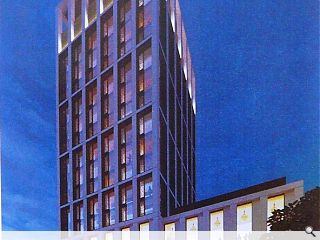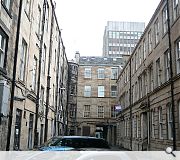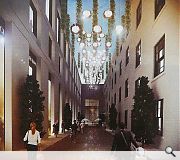Nord pen their biggest project yet
August 26 2011
Nord Architects have submitted plans for an ambitious makeover for Royal Exchange Square following a ten year process of site acquisitions by the landowner, Glenerrol Ltd.The developer is seeking to demolish a sandstone terrace tucked away in a courtyard immediately behind the Square to make way for a mixed use development comprising a 100bed hotel, retail, bars, restaurant and casino.
Outlining his scheme to the Glasgow Urban Design panel Alan Pert noted that at present only 25% of upper levels are in use: “Big areas are being brought back into beneficial use. The proposal will connect levels throughout and fill the existing space which is currently unused.”
Remarking upon the headline feature of his plans Pert said: “The tower incorporates an outdoor terrace which is set back from the skin of the building. The terrace will enable people to walk around outside with views over Glasgow.”
Controversially however a sandstone terrace at South Exchange Court will require to be demolished to make way for it all as Pert explained: “We are not condemning the structure; however our preferred option is demolition to ensure the project is viable. It is recognised that just because the building is in a poor courtyard we can’t just knock it down.
Pert stressed that façade retention had been considered but dismissed as the existing building features an elevated ground floor that precludes street interaction.
The scheme, Pert asserts, will replace the “dark and dingy” existing courtyards, currently utilised for parking and refuse collection, to offer a variety of small retail units and outlets.
Despite Pert’s best efforts the GUD panel insist that a rectangular floorplate could reduce the height (and impact)by six floors – an option earlier dismissed by the architect as a “slab building” which would present a “bigger issue” in relation to Royal Exchange Square.
|
|
10 Comments
#1 Posted by Brian on 27 Aug 2011 at 09:19 AM
I agree .leave the place alone.
#2 Posted by RBR on 27 Aug 2011 at 11:39 AM
Conservationists take a seat. The terrace is mediocre at best; we must stop simultaneously fetishizing old stone and demonizing postwar concrete. I wonder what Gareth Hoskins thinks? His office is after all behind the coloured blinds on the top floor of Charlotte House- which is actually a contextually sensitive, rather beautiful building- almost proto-Nord, if it was a little more asymmetrical.
#3 Posted by FW on 28 Aug 2011 at 11:22 AM
Why don't you just say what you mean Crawford.
Hardly a cynical act and yes stop the press development is all about money, much like the origins of the development of Glasgow after the 1800' s and , the merchant city and the city centre. Hard to tell really if this is a good or bad architecture, except to say that NORD have a good reputation, so I would trust them.
Hardly a cynical act and yes stop the press development is all about money, much like the origins of the development of Glasgow after the 1800' s and , the merchant city and the city centre. Hard to tell really if this is a good or bad architecture, except to say that NORD have a good reputation, so I would trust them.
#4 Posted by D to the R on 28 Aug 2011 at 13:42 PM
There are architects in glasgow and then there are good architects. NORD fall into the later category - they are contextual and sympathetic in their architecture - commercial development is ALWAYS about money (it makes the world go round) but with architects like NORD you at least stand a small chance of adding a healthy portion of good architecture to the mix.
Ps. ANY development in glasgow is a good sign!
Ps. ANY development in glasgow is a good sign!
#5 Posted by kevin toner on 28 Aug 2011 at 14:13 PM
A tower rising behind the Park Circus enclosure wouldn’t be allowed, so why would here be an exception?
To aid this argument as below, firstly note the following historical placemaking nous that occurred within the related Park District, where the clustered city skyline towers that neighbour Park Circus haven’t actually ever compromised the skyscape of the Circus, even from each storey within the enclosure. So sightlines were paramount.
The Royal Exchange Square is by comparison an enclave in the downtown, where sightline control is doable at pedestrian level. This particular planned urban square is an almost 200 year old [i.e. a relatively recent] world class example that’s skyscape is intrinsic to its spatial experience and as part of the city’s urban heritage.
The following is a discussion on how the Square's significance should disadvantage the merit/s of the NORD scheme.
Firstly, it wouldn’t be conducive to apply any height restriction on the east edge of Queen Street, i.e. as the planned square did not anticipate control over the views looking east by being open ended. However, a control of height on the back lane and court buildings can protect the views of the Square looking west.
Simple site sections will reveal the maximum heights that should apply to any lofty buildings west of Queen Street’s western edge within the super-block. This won’t harm ‘development’ potential or even ambitiousness, i.e. provided that footprints are as squat and/or lengthy as possible.
The latter approach however might entail making court/lane building footprints taller from ground to parapet, which will arguably be out of character (!) Such spaces are now being valued for their ‘character and appearance’, sense of place, history, etc. NORD appears to have addressed this well by having a base element that reflects the surrounding heights etc.
The aforementioned GUD Panel report (as online) has emphasised that the NORD scheme tower element is spreadable over a squat plan in order to encourage an overall reduction in height etc. This is a half way house that translates into being at least 2 storeys too high for the Square. Double the existing building’s height should be the maximum to protect the Square’s skyscape.
Now more about that sophistication in the placemaking of the past that justifies such attention and respect, past future and present.
The Square’s flanking/mirrored buildings were planned with ‘building lines’ that staggered to narrow the width of the Square at its widest point and therefore to minimise the expected sightline demands at the north/south stretch behind GoMA. This has helped to encourage higher buildings. However, a similarly demanding but panoramic sightline is noted at the other end (i.e. from the mouth of Ingram Street) that should preclude any stepping upwards to the east. 2/4 storeys could be stepped up if it wasn’t for the imminent violation of such an outstanding panoramic view.
Note that a young Charles Wilson (who planned Park Circus later) was articled to David Hamilton during the Square’s creation, signifying a lineage of nous that has helped to retain the treasured skyscapes of these masterly planned urban spaces. We might continue to take heed by planning considerate urban renewal or redevelopment that acknowledges the feat of such sophistications, i.e. in cases such as the NORD case where building conservation cannot be implemented?
The NORD proposal is extremely contentious regarding the demolition of an important section belonging to a Grade B Listed Building.
This ‘hidden away’ terrace wing (see photo) is found behind the south of the Square and will no doubt be viewed as significant for having one of the prevalent ‘Characters’ within the Conservation Area Character Appraisal, which of course Conservation Area Designation seeks to “protect or enhance”.
By proposing to replace this, NORD has rightly enhanced the space by repeating the existing footprint to an equal height with the rear of the surrounding Grade A Listed Buildings of the Square; and hence the necessity for their tower above, which unfortunately would impact on the Square.
Alternatively, the consolation of losing the tower and keeping the top floor (roof level restaurant) not higher than double the height of the existing building would be that a direct conversation with GoMA’s massive cupola at the front/centre of the Square could be enjoyed in elevation, while blotting out GoMA’s unsightly roofscapes. The City of Architecture is a help not a hindrance!
Also, final questions for the conservationists: as Glasgow has got a world class downtown square in the first place, why not protect its skyscape hand in hand with its architecture instead of protecting its architecture alone? Can a height restriction therefore be put in place before any unwitting damage occurs or accrues?
#6 Posted by FW on 28 Aug 2011 at 15:46 PM
Phew........exhausted reading this. Why would'nt a tower behaind Park Circus be allowed, if it's an excellent tower. Treasured by who, nothing in Glasgow is so treasured it can't be added to with some sensitivity
#7 Posted by kevin toner on 28 Aug 2011 at 17:10 PM
FW – 2 answers to your 2 questions, the latter more philosophical:
1) Wouldn't be allowed by the city council, community groups, amenity societies, etc. or could I be wrong?
2) i.e. “treasured” (i.e. valued) by those who have the memory of it in an untarnished as possible state – that’s almost 200 years of folk to date, ranging from those who’ll value it as an enjoyment through to those who’ll value it as a challenge - trusting you are of the challenge rather than enjoyment camp. So far the latter have the upper hand, but watch this space!
1) Wouldn't be allowed by the city council, community groups, amenity societies, etc. or could I be wrong?
2) i.e. “treasured” (i.e. valued) by those who have the memory of it in an untarnished as possible state – that’s almost 200 years of folk to date, ranging from those who’ll value it as an enjoyment through to those who’ll value it as a challenge - trusting you are of the challenge rather than enjoyment camp. So far the latter have the upper hand, but watch this space!
#8 Posted by FW on 28 Aug 2011 at 20:06 PM
Actually I'd consider myself to be in both camps, that's the trouble with the conservationist philosophy, it's either one damn thing or another.
#9 Posted by Chris Ditchfield on 29 Aug 2011 at 16:22 PM
@RBR - Charlotte House beautiful !! Eh?? Doubt you'd get a single person walking up Queen St to agree!
The proposals look broadly sensible to me - the sandstone properties are backlying and not seen by other than the occupiers. Development is badly needed to create jobs and stimulate the economy in the City Centre.
Pontificating about the beauty of one set of proposals or another is easy - getting the funding and having the cohones to do something about it in this market is entirely another.
I doubt the tower would be easily seen fom the square. The average member of the public rarely looks up higher than shop fascia height anyway.
The proposals look broadly sensible to me - the sandstone properties are backlying and not seen by other than the occupiers. Development is badly needed to create jobs and stimulate the economy in the City Centre.
Pontificating about the beauty of one set of proposals or another is easy - getting the funding and having the cohones to do something about it in this market is entirely another.
I doubt the tower would be easily seen fom the square. The average member of the public rarely looks up higher than shop fascia height anyway.
#10 Posted by Sven on 1 Sep 2011 at 15:10 PM
Glasgow has lost so much historic architecture, that locals, tourists and film directors want to see. The buildings on the right hand side are attractive, the left looks like the back of a tenement. Side streets in Glasgow do not work - this will not be a Multrees Walk, it will be a urine soaked alley way covered in graffiti and an other mournful loss of Glasgow's history.
Post your comments
Read previous: Edinburgh Trams to terminate at Haymarket
Back to August 2011
Like us on Facebook
Become a fan and share
News Archive
Search News
Features & Reports
For more information from the industry visit our Features & Reports section.





